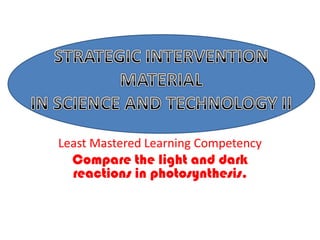
Photosynthesis Light and Dark Reactions
- 1. Least Mastered Learning Competency Compare the light and dark reactions in photosynthesis. STRATEGIC INTERVENTION MATERIAL IN SCIENCE AND TECHNOLOGY II
- 3. Guide cardWhat is photosynthesis? Students Note After reading this page I still do not understand Now I understand what the lesson is all about. What I think about the things to do. Easy Hard For this lesson, I want to study it Alone With one of my classmates. Within the group Plants, algae, and other chlorophyll-bearing organisms capture light energy and use it to produce food. This energy is passed on to animals that feed directly on plants or on other animals that have fed on plants. The entire process of capturing light energy to produce food is called photosynthesis. The equation is: 6CO2 + 6H2O + light chlorophyll (energy) C6H12O6 + O6
- 4. Photosynthesis is two stage process. Thelight reaction that took place in the grana of the chloroplast and the dark reaction that took place in he stromaof the chloroplast. In the light-dependent process, light strikes chlorophyll in such a way as to excite electrons to a higher energy state. In a series of reactions, the energy is converted (along an electron transport process) into ATP and NADPH. Water is split in the process, releasing oxygen as a by product of the reaction. The ATP and NADPH are used to make C-C bonds in the dark reaction. The photosynthetic process, in which food(sugar) molecules are formed from the carbon dioxide in the atmosphere with the use of ATP can occur in the dark as long as ATP is present. Remember….
- 5. Photosynthetic General Equation
- 6. What happens in photosynthesis
- 9. Activity card 1 Arrange the jumbled letters to produce a word. _________ 1. TAP- formed during light reaction. _________ 2. YGXONE- gas given off by plants. _________ 3. TRELECON- energized during reaction. _________ 4. AWTRE- splits into hydrogen and oxygen. _________ 5. LOPHYOLRCHL- traps light energy.
- 10. Activity card 2Study the diagram below and complete it using the words in the box.SUN Light energy Is absorbed by Energy carrier that becomes ENERGIZED CHLOROPHYLL that supplies energy to split add and p 2H to That are trapped by NADP (H acceptor) That is released ( energy carrier) forming forming That stores energy For use in the dark reaction
- 11. Word boxfor activity card 2 Water Oxygen NADPH2 Water Chlorophyll
- 12. Activity card 3 THE DARK REACTION The fixing of carbon in a carbohydrate Combines with A five carbon sugar in the chloroplast ( CO2 acceptor) That is gain used To combine with CO2 by combining and substituting H for a phosphate To form A very unstable and RDP That splits quickly and forms That can be used As nutrient or converted to H2O that is released As a by- product PGA, a 3-carbon compound and forms that combines with 2H supplied by NADPH2 from the light reaction ( energy supplied by conversion of ATP to ADP )
- 13. Word Boxfor Activity Card 3 PGAL 6 carbon sugar ADP 2 molecules Glucose Carbon dioxide
- 14. Check it out! Study the following illustrations below. Differentiate each stage of photosynthesis. Assessment Card 1 Students Note What I already know about this page? ______________________________________ What I learned from this page? ______________________________________ What I still want to know about this page? ______________________________________ What reactions occur? A B
- 15. Assessment Card 2.Self-checkEncircle the letter of the correct answer Which of the following reactions is also known as photo phase? a. Light dependent b. Light independent c. Anaphase Which of the following reactions is also known as synthesis phase? a. Light dependent b . Light independent c. Metaphase 3. What kind of energy is used to split two molecules of water? a. Light b. Proton c. Neutron 4. What is the energy source of the cell? a. NAD b. ADP c. ATP 5. What is made up of 5-carbon sugar and an important carbon dioxide acceptor? a. ATP b. RUDP c. PGAL
- 16. 6. Which co-enzyme capture the hydrogen molecules? a. NADP b. RUDP c. PGAL How many carbon, hydrogen, and oxygen are present in a glucose molecule? a. C6H12O6 b. C5H11O2 c. C12H6O12 8. What are the end product in dark reactions? a. ATP and NADPH b. sugar c. enzyme 9. In which part of the cell does light reactions take place? a. thylakoids b. stroma c. stomata 10. In which part of a plant cell does dark reactions take place? a. thylakoids b. stroma c. stomata
- 17. Enrichment Card Sentence completion… The ___________ is the conversion of light energy into chemical energy. The light dependent reaction includes the conversion of __________ energy into electron energy, then into short-term energy storage __________. The __________ reaction involves the conversion of short-term energy storage to long term energy storage ___________. Students note What I already know about this page? __________________________________________________________ What I learned from this page? __________________________________________________________ What I still want to know about this page? __________________________________________________________
- 19. Reference Card Dela Cruz, Susana B. Biology ( Pheonix Next Century) Agar, Irene C. et.al. Science and Technology II Internet Explorer
- 20. Answer card Activity No. 1 1. ATP 2. oxygen 3. electron 4. water 5. chlorophyll Activity No. 2 Chlorophyll Water Oxygen NADPH2 ATP
- 21. Activity No. 3 CO2 6 carbon sugar PGAL Glucose ADP Assessment No. 1 Dark reaction or light –independent reaction Light reaction or light- dependent reaction
- 22. Assessment No. 2. 1. A 6. A 2. B 7. A 3. A 8. B 4. C 9. A 5. B 10. B Enrichment Card 1. Photosynthesis 2. Light 3. ATP 4. Dark 5. Glucose
